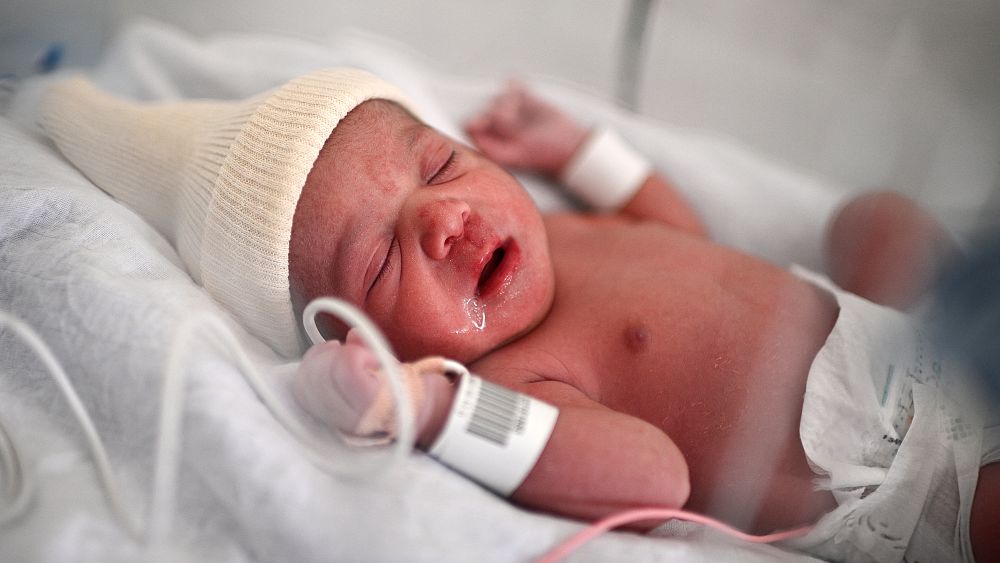
More than 4 million babies have been born in the European Union every year in the last three decades, but these numbers are showing a downward trend.
In 2021, 4.09 million babies were born. This is the second lowest figure since 1960. The lowest figure was recorded in 2020, when 4.07 million babies were born.
The fertility rate, which reflects the number of live births per woman, has changed remarkably across European countries in the last 20 years. It decreased in 11 of the 27 EU members states between 2001 and 2021.
Which countries have the highest and lowest fertility rates in Europe? How has fertility changed across Europe in the last two decades? How do the shares of children of foreign-born and native-born mothers vary in the EU?
France has the highest fertility rate
In 2021, France had the highest fertility rate among the EU member states with 1.84 live births per woman according to Eurostat, the statistical office of the EU. Malta had the lowest rate with 1.13 live births. This average for the EU as a whole was 1.53.
France is followed by Czechia (1.83), Iceland (1.82) and Romania (1.81).
While the highest fertility rate is seen in a (partially) Mediterranean country, live births per woman are remarkably lower in some other Mediterranean countries such as Malta (1.13), Spain (1.19), Italy (1.25), Cyprus (1.39) and Greece (1.43).
Fertility rates were as follows in other countries: 1.72 in Denmark, 1.7 in Turkey, 1.61 in the UK, 1.58 in Germany, and 1.35 in Portugal.
Children born in the EU: Lowest number recorded in 2020
Looking at the number of children born in the EU, the lowest number was recorded in 2020 at 4.07 million. There has recently been a downward trend in the number of births in the EU, which began in 2008, a year that saw 4.68 million births.
How has the fertility rate changed?
The fertility rate increased by 8 per cent in the EU between 2001 (1.43 births per woman) and 2021 (1.53 births per woman).
The highest rise was recorded in Czechia at 59 per cent, followed by Romania (43 per cent) and Slovakia and Slovenia (both 36 per cent).
The highest decrease is seen in Turkey
Turkey, which is one of the most populated countries in Europe, experienced the largest decline in fertility rate in this period. It fell from 2.38 in 2001 to 1.7 in 2021, which corresponds to a decrease of 29 per cent. However, Turkey is still ranked eighth out of 37 countries on the list of highest fertility rates.
The fertility rate also fell by 24 per cent in Malta, 16 per cent in Finland, 7 per cent in Portugal and 5 per cent Netherlands. The decline was more limited in Spain and France (3 per cent), and it was only one per cent in the UK.
At what age do women give birth to their first child?
In 2021, the average age of women giving birth to their first child was 29.7 years in the EU. This age has been steadily rising over the years; it was 28.8 years in 2013.
In 2021, the mean age of women at the birth of the first child was highest in Italy and Spain at 31.6 years in both countries.
This age was lowest in Bulgaria at 26.5 years, followed by Albania (26.6 years) and Turkey (26.7 years).
The mean age of women at the birth of their first child was as follows in other countries: 31.2 years in Ireland, 31 years in Greece, 30.9 years in England and Wales, 30.1 years in Germany, and 29.1 years in France.
Are these mothers foreign-born or native-born?
The shares of children of foreign-born and native-born mothers vary significantly across Europe. Children of foreign-born mothers range from 1 per cent of the total in Serbia to 65 per cent of the total in Luxembourg. This value is 20 per cent or more in half of the countries considered here.
In 2021, the shares of children of foreign-born mothers were 29 per cent in Germany, the UK and Sweden. This value was 23 per cent in France.
Besides Serbia, the shares of children of foreign-born mothers were 3 per cent or less in Poland, Turkey, Lithuania, Slovakia and Bulgaria.
The shares of children of foreign-born mothers increased in most EU countries between 2013 and 2021.
Malta saw the highest increase, at 22 percentage points (pp), followed by Greece (6 pp) and Spain, Portugal, and Romania (5 pp for each country).

